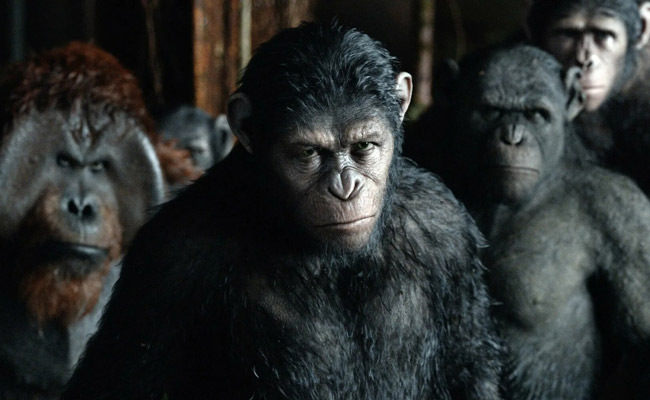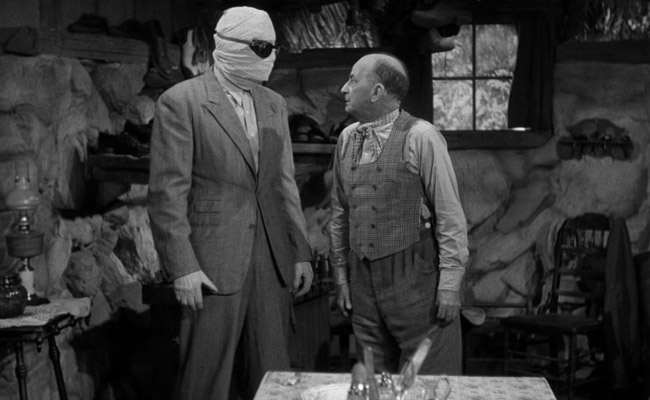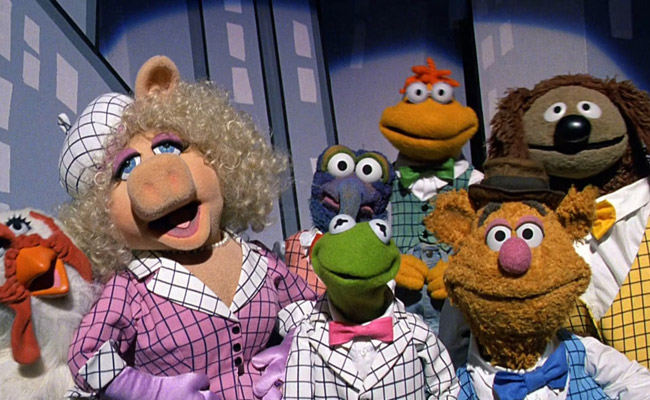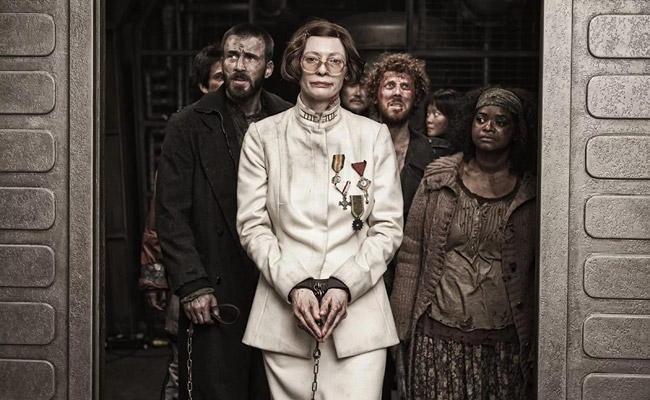
Chernin Entertainment
It’s been a weird week at Hotchka Central so let’s just get right into this week’s new movie premieres. We’ve got sequels, awards nominees, award winners, cult classic, literary and stage adaptations, one film that took twelve years to complete, and one that was adapted into a TV series. Want to learn more? Scroll down the list to see the new movies by year and tell us if any of your favorites are celebrating milestone anniversaries!
1924
- July 13 – Tiger Thompson (USA, Hunt Stromberg Productions)
- July 15 – Behind the Curtain (USA, Universal Pictures)
- July 15 – In Fast Company (USA, Carlos Productions)
- July 15 – Rough Ridin’ (USA, Approved Pictures)
Behind the Curtain was based on a story by William J. Flynn, a former Director of the Bureau of Investigation. In Fast Company is preserved at Filmmuseum EYE Institute. Rough Ridin’ is considered a lost film. It was remade in 1934 as Boss Cowboy.
1934
- July 13 – Kiss and Make-Up (USA, Paramount Pictures)
- July 13 – Stamboul Quest (USA, Metro-Goldwyn-Mayer)
- July 13 – The Old Fashioned Way (USA, Paramount Pictures)
- July 14 – Midnight Alibi (USA, First National Pictures)
- July 14 – Side Streets (USA, First National Pictures)
- July 15 – Fifteen Wives (USA, Invincible Pictures Corp.)
- July 15 – The Defense Rests (USA, Columbia Pictures)
- July 17 – Fighting Hero (USA, Reliable Pictures Corporation)
- July 17 – I Give My Love (USA, Universal Pictures)
Kiss and Make-Up was based on the play Kozmetika by István Békeffy.
Stamboul Quest was based on a real person, possibly Elsbeth Schragmüller who used the code name ‘Fräulein Doktor’. The studio was careful how the character was portrayed as she was still alive, and a drug addict, living in a sanatorium in Switzerland, and they were concerned about being sued for libel.
The script for The Old Fashioned Way was based on a story by Charles Bogle, a writing pseudonym of the film’s star W.C. Fields. The film afforded Fields a chance to demonstrate his considerable juggling skills, his vaudeville speciality.
Midnight Alibi is an adaptation of Damon Runyon’s 1933 short story The Old Doll’s House. A print of the film is preserved in the Library of Congress.
Side Streets is known in the UK as A Woman in Her Thirties. The Defense Rests is also known as Take the Witness.
1944

Universal Pictures
- July 11 – Marine Raiders (USA, RKO Radio Pictures)
- July 12 – The Invisible Man’s Revenge (USA, Universal Pictures)
- July 13 – Louisiana Hayride (USA, Columbia Pictures)
- July 14 – Call of the Rockies (USA, Republic Pictures)
- July 14 – Summer Storm (USA, Angelus Pictures)
- July 15 – Delinquent Daughters (USA, American Productions Inc.)
- July 15 – Idle Roomers (USA, short, Columbia Pictures)
- July 17 – Hotel Reserve (UK, RKO Radio Pictures)
- July 17 – Return of the Ape Man (USA, Sam Katzman Productions)
- July 17 – Take It or Leave It (USA, Twentieth Century Fox)
Marine Raiders was filmed at the Marine base at Camp Elliott, near San Diego, with Captain Clay Boyd as the technical advisor. Shortly after filming, actor Robert Ryan enlisted in the United States Marine Corps in January 1944 serving as a Drill Instructor at Camp Pendleton.
The Invisible Man’s Revenge does not follow the continuity of Universal’s previous ‘Invisible Man’ films. The studio hoped Claude Rains, star of the original film, would return but Jon Hall, star of 1942’s Invisible Agent, starred as the Invisible Man character Robert Griffin, a different character with the same last name.
Summer Storm was based on Anton Chekhov’s 1884 novel The Shooting Party. The filmed earned an Oscar nomination for Best Music Scoring for Karl Hajos.
Delinquent Daughters is also known as Accent on Crime.
Idle Roomers is the 80th Three Stooges short of 190 produced by Columbia Pictures. The film’s plot device would be used in the 1953 Woody Woodpecker short Belle Boys. The film introduced Christine McIntyre, who would work with the Stooges for the remainder of the series. This was the first film in which it became apparent that Curly Howard’s performance was being affected by his wild lifestyle following his divorce, with a slower acting style and a deeper voice due to his drinking.
Hotel Reserve was based on Eric Ambler’s 1938 novel Epitaph for a Spy. It was unusual in that it was produced and directed by a trio: Lance Comfort, Mutz Greenbaum and Victor Hanbury.
The working title for Return of the Ape Man was Revenge of the Ape Man.
Take It or Leave It was a big screen version of the popular radio quiz show of the same name, with host Phil Baker playing himself in the movie. The film’s only real star was Phil Silvers, who appeared briefly in a pre-credits prologue explaining the film’s premise. The film was produced on an exceptionally low budget for a major studio film, utilizing film clips to accompany the quiz show questions.
1954
- July 13 – Beautiful Stranger (UK, Marksman Productions Ltd.)
- July 13 – Dance Little Lady (UK, George Minter Productions)
- July 13 – Seagulls Over Sorrento (UK, Boulting Brothers)
- July 16 – River Beat (USA, Insignia Films)
Beautiful Stranger was released in the US on November 5, 1954 as Twist of Fate. Dance Little Lady opened in the US on December 25, 1955. Seagulls Over Sorrento opened in the US on November 10, 1954 as Crest of the Wave.
The working title for Beautiful Stranger was Lifeline. Original male lead Walter Rilla did not get along with star Ginger Rogers, unhappy with his screen time compared to Jacques Bergerac, who was married to Rogers at the time. Rilla was replaced with Stanley Baker ten days into filming.
Seagulls Over Sorrento is based on the play of the same name by Hugh Hastings. The film was one of three Gene Kelly made in Europe over an 18-month period to make use of frozen MGM funds. Filming was completed in July 1953, but MGM could not release it in the UK until the play finished its run.
River Beat was the directorial debut of Guy Green.
1964
- July 14 – The Pumpkin Eater (UK, Romulus Films)
- July 16 – Eat (USA, Andy Warhol)
The Pumpkin Eater originally opened in France on May 15, 1964, and was released in the US on November 9. It was adapted by Harold Pinter from the 1962 novel of the same title by Penelope Mortimer. Anne Bancroft earned her second Best Actress Oscar nomination for her work. She also won the Golden Globe and BAFTA.
Eat is an art experiment in which Andy Warhol captures the simple act of a man eating mushrooms.
1974
- July 11 – The Legend of the 7 Golden Vampires (Hong Kong, Hammer Films)
- July 11 – The Tamarind Seed (USA, Jewel Productions)
- July 12 – Carry On Dick (UK, The Rank Organisation)
- July 17 – Golden Needles (USA, Sequoia Pictures)
- July 17 – Mr. Majestyk (USA, The Mirisch Corporation)
- July 17 – My Name Is Nobody (USA, Rafran Cinematografica)
- July 17 – The Education of Sonny Carson (USA, Paramount Pictures)
- July 17 – The Mad Adventures of Rabbi Jacob (USA, Les Films Pomereu)
The Legend of the 7 Golden Vampires was released in the US in a shortened form in June 1979 as The 7 Brothers Meet Dracula. Carry On Dick was released in the US on December 25, 1974. My Name Is Nobody originally opened in West Germany on December 13, 1973. The Mad Adventures of Rabbi Jacob originally opened in France on October 18, 1973 as Les aventures de Rabbi Jacob.
The Tamarind Seed is based on the 1971 novel of the same name by Evelyn Anthony. It was the first film produced by Lorimar Productions. It was Julie Andrews’ first film in four years since Darling Lili.
Carry On Dick was the 26th in the series of 31 Carry On films. It features the last appearances of Sid James after 19 films, Hattie Jacques after 14, Barbara Windsor after nine films, Margaret Nolan after six, and Bill Maynard after four films. It was also the 20th and last film written by Talbot Rothwell.
Golden Needles is also known as The Chase for the Golden Needles. It was shot on location in Hong Kong. While Mr. Majestyk was an original story, the name Majestyk was taken from the 1969 crime novel The Big Bounce.
The Education of Sonny Carson was based on the best-selling autobiography of Sonny Carson.
1984

Henson Associates
- July 13 – The Last Starfighter (USA, Lorimar Productions)
- July 13 – The Muppets Take Manhattan (USA, Henson Associates)
Along with Disney’s Tron, The Last Starfighter was one of the earliest films to employ 27-minutes of computer-generated imagery for its starships, environments and battle scenes. It was Robert Preston’s final theatrical film. His role was written specifically for him, based on his performance as Professor Harold Hill in The Music Man. Wil Wheaton had a few lines of dialogue that were ultimately cut from the film, but he still is visible in the background of several scenes.
The Muppets Take Manhattan is the third theatrical film to star The Muppets. A fantasy sequence in the film introduced the Muppet Babies. It was the first film to be solely directed by Frank Oz, as Jim Henson needed a break after directing The Great Muppet Caper and The Dark Crystal back-to-back. The film’s first draft screenplay was titled The Muppets: The Legend Continues, but Oz felt it was too jokey. Henson allowed Oz to tinker with the script to develop the characters more. Dustin Hoffman was originally to have a cameo spoofing producer Robert Evans, but Hoffman felt it would be offensive and dropped out, taking a list of guest stars with him. Stars who did make cameos include Art Carney, James Coco, Dabney Coleman, Gregory Hines, Linda Lavin, Liza Minnelli, Joan Rivers, and Brooke Shields. The film was shot on location in New York City the summer before its release.
1994
- July 13 – Back in Action (USA, Performance Pictures Inc.)
- July 15 – Angels in the Outfield (USA, Walt Disney Pictures)
- July 15 – Mi Vida Loca (USA, Channel Four Films)
- July 15 – True Lies (USA, Lightstorm Entertainment)
Mi Vida Loca originally opened in France on June 8, 1994. It is also known in the US as My Crazy Life.
Back in Action was intended to be a sequel to 1992’s Talons of the Eagle, with that film’s three stars Billy Blanks, Bobbie Phillips and Jalal Merhi. The American distributor was reluctant to work with Merhi and he was squeezed out of the film, replaced with Roddy Piper. The film was rewritten from scratch using a basic stock buddy movie template.
Angels in the Outfield is a remake of the 1951 film of the same name. It features a cast of relative unknowns who became stars later including lead Joseph Gordon-Levitt, Adrien Brody, Matthew McConaughey and Neal McDonough. The film was followed by two made-for-TV sequels.
Mi Vida Loca featured mostly unknown actors, some of whom were actual gang members from Echo Park. It marks the film debuts of Salma Hayek and Jason Lee in small roles. The film is dedicated to Nica Rogers, a member of the Echo Park Locas who appears briefly in the film and died after filming concluded. Director Allison Anders and Film Independent established a scholarship program to help assist the kids of Echo Park with higher education after the movie’s release.
True Lies is based on the 1991 French comedy film La Totale! It was the first film from James Cameron’s Lightstorm Entertainment to be distributed under Cameron’s production deal with 20th Century Fox, as well as the first major project for visual effects company Digital Domain. It was the first film to cost $100 million. Filming took about seven months. It was the third highest grossing film of 1994. Jamie Lee Curtis won the Golden Globe for Best Actress – Motion Picture Musical or Comedy. It earned an Oscar nomination for Visual Effects.
2004
- July 14 – Ae Fond Kiss… (France, Bianca Film)
- July 15 – House of Flying Daggers (Honk Kong, China Film Co-Production Corporation)
- July 15 – If Only (Lebanon, Outlaw Productions)
- July 16 – 9 Songs (Indonesia, Revolution Films)
- July 16 – A Cinderella Story (USA, Dylan Sellers Productions)
- July 16 – I, Robot (USA, Davis Entertainment)
- July 16 – The Clearing (USA, Searchlight Pictures)
Ae Fond Kiss… was released in the US in limited release on November 26, 2004 as Just a Kiss. House of Flying Daggers opened in limited release in the US on December 3, 2004. If Only made its TV premiere in the US on January 15, 2006. 9 Songs opened in limited release in the US on July 22, 2005.
House of Flying Daggers was submitted to the Academy Awards for Best Foreign Language Film but did not receive a nomination. It was nominated, however, for Best Cinematography. It also received nine BAFTA nominations. The film was intended to be Anita Mui’s final appearance but she died of cervical cancer before her scenes were filmed. Instead of recasting her role, the script was altered and the film was dedicated to her memory. To prepare for her role, Zhang Ziyi lived for two months with a blind girl who had lost her sight at the age of 12 because of a brain tumor. Takeshi Kaneshiro injured his leg when he went horseback riding. As a result, he is seen sitting or kneeling in two scenes to alleviate the pain.
9 Songs was controversial upon original release due to its sexual content, which included unsimulated footage of the two leads, Kieran O’Brien and Margo Stilley, having sexual intercourse and performing oral sex as well as a scene of ejaculation.
A Cinderella Story was successful enough to spawn a series of five direct-to-video films to date, each telling its own unique Cinderella story.
I, Robot‘s title was taken from Isaac Asimov’s classic 1950 short story collection, but the screenplay is based on an original story by Jeff Vintar, who also co-wrote the script titled Hardwired with Akiva Goldsman. When the title was changed to I, Robot, Vintar added Asimov’s Three Laws of Robotics to the story and renamed the female lead from Flynn to Susan Calvin, a character in the original story. Goldsman was brought on specifically to write for Will Smith. The film earned an Oscar nomination for Visual Effects but lost to Spider-Man 2. The project had originally been acquired by Disney for Brian Singer to direct but that never moved forward. 20th Century Fox later acquired the rights for Alex Proyas and star Arnold Schwarzenegger. Will Smith took over the role when Schwarzenegger had scheduling issues. Denzel Washington turned down the role of Detective Del Spooner. Proyas later said making the movie was an unpleasant experience due to the micromanagement from pre- to post-production.
The Clearing was the directorial debut of Pieter Jan Brugge. The film is loosely based on the real life kidnapping of Gerrit Jan Heijn that took place in the Netherlands in 1987. The film was shot on location in Asheville, North Carolina and Pittsburgh, PA.
2014

Opus Pictures
- July 11 – Boyhood (USA, limited, Detour Filmproduction)
- July 11 – Dawn of the Planet of the Apes (USA, Chernin Entertainment)
- July 11 – Rage (USA, limited, Saturn Films)
- July 11 – Road to Paloma (USA, limited, Boss Media)
- July 11 – Snowpiercer (USA, Opus Pictures)
Rage, titled Tokarev in most of Europe and Australia, originally premiered online in the US on May 9, 2014. Snowpiercer originally opened in South Korea on August 1, 2013.
Filming for Boyhood took place from 2002 to 2013. The project began without a completed script, with only basic points and the ending written. Richard Linklater would write the next year’s script after reviewing footage from the previous year. He allowed the actors to contribute to the script, incorporating their own life experiences during the course of the shoot. The film’s distributor, IFC, agreed to a budget of $200,000 per year or $2.4 million over the 12-year shoot. Linklater was not allowed to sign his cast to contracts due to the De Havilland Law, which made it illegal to contract someone for more than seven years. Linklater told Ethan Hawke he’d have to complete the film if Linklater died. Scripts were sometimes completed the night before shooting, and Hawke has stated that a discussion about additional Star Wars films is the only improvised moment in the movie. Filming usually took place for three or four days, twice a year, and when Patricia Arquette got the lead role in the TV series Medium she filmed her scenes on weekends. Linklater had always titled the film Boyhood, but decided to change it to 12 Years in 2013. He then had to change it back because of 12 Years a Slave, released in 2013. Linklater shot the film on 35mm as it was the most stable medium to use over the course of 12 years, whereas going with HD digital could have given the film several different looks. The film earned five Golden Globe nominations, winning Best Motion Picture – Drama, and Best Supporting Actress (Arquette). It also received five BAFTA nominations, winning Best Director and Best Film, and six Academy Award nominations, winning Best Supporting Actress.
Dawn of the Planet of the Apes is the second of the modern Planet of the Apes series. Rupert Wyatt was attached to return as director but left the project in September 2012, with Matt Reeves taking over. Andy Serkis was the only major cast member expected to return from the first film. The film earned an Oscar nomination for Visual Effects.
Snowpiercer is based on the French climate fiction graphic novel Le Transperceneige by Jacques Lob, Benjamin Legrand and Jean-Marc Rochette. This was the English-language directorial debut for Bong Joon-ho. The fourth volume of the original Snowpiercer graphic novel series, Snowpiercer: Terminus, published in 2019, serves as a sequel to the film, establishing it as being set in the same continuity as the original graphic novels. Tilda Swinton had decided she did not want to make any more films — which she does at the end of every film — and decided to do Snowpiercer only if she could have fun, which led to the very specific look and mannerisms of her character. Ed Harris didn’t care what he was asked do do, he just wanted to make a film with the director, whom he admired. Filming required a 100-meter replica of the title train. Bong shot the film so the train’s tail section was always to the left of the characters and the engine to the right to give the audience the sense that whichever way the shot it moving, that’s where the characters were going. Twenty-six train cars were constructed and placed on gimbals to give them a true sense of movement including perfect curves. Bong stated that they would often feel motion sickness due to the realistic movement of the gimbal.
